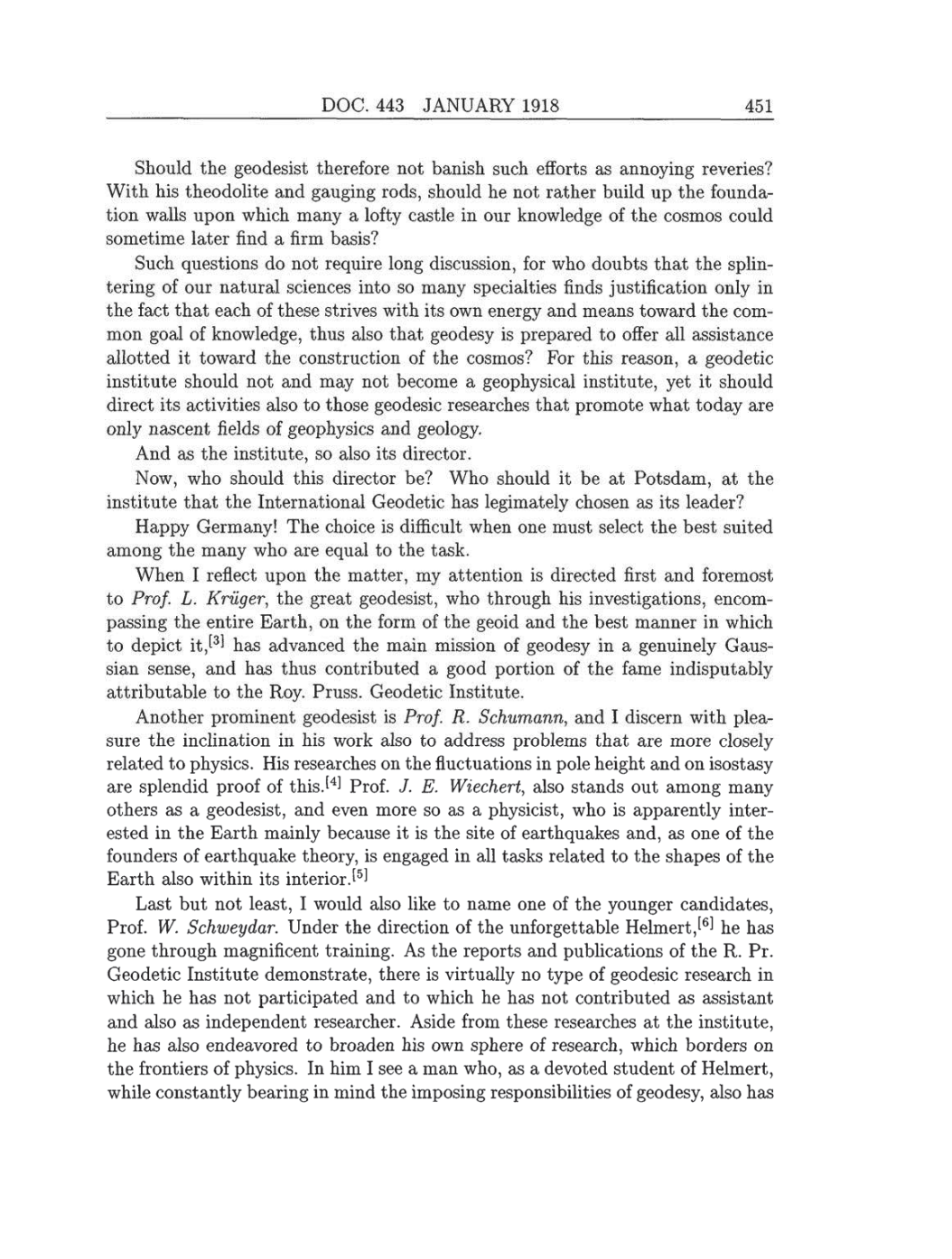DOC.
443
JANUARY
1918
451
Should
the
geodesist
therefore
not
banish such efforts
as annoying
reveries?
With
his theodolite
and
gauging
rods,
should he
not
rather
build
up
the
founda-
tion
walls
upon
which
many
a
lofty
castle in
our knowledge
of the
cosmos
could
sometime
later
find
a
firm basis?
Such
questions
do not
require long discussion,
for
who
doubts that the
splin-
tering
of
our
natural
sciences into
so many
specialties
finds
justification
only
in
the fact that
each of these strives with its
own energy
and
means
toward the
com-
mon
goal
of
knowledge,
thus
also
that
geodesy
is
prepared
to
offer
all assistance
allotted it
toward
the
construction of the cosmos? For this
reason,
a
geodetic
institute should not and
may
not become
a
geophysical
institute,
yet
it should
direct its
activities also to those
geodesic
researches
that
promote
what
today
are
only
nascent
fields of
geophysics
and
geology.
And
as
the
institute,
so
also its director.
Now,
who should
this
director be? Who should
it
be at Potsdam, at
the
institute that the International
Geodetic
has
legimately
chosen
as
its
leader?
Happy Germany!
The
choice is
difficult when
one
must select
the best suited
among
the
many
who
are
equal
to
the
task.
When
I
reflect
upon
the
matter,
my
attention
is
directed first and foremost
to
Prof.
L.
Krüger,
the
great
geodesist,
who
through
his
investigations,
encom-
passing
the
entire Earth,
on
the
form
of
the
geoid
and
the
best
manner
in which
to
depict
it,[3]
has advanced
the
main mission
of
geodesy
in
a genuinely
Gaus-
sian
sense,
and
has
thus contributed
a
good
portion
of
the
fame
indisputably
attributable
to
the
Roy.
Pruss. Geodetic
Institute.
Another
prominent geodesist
is
Prof.
R.
Schumann,
and I discern
with
plea-
sure
the
inclination in his work also
to
address
problems
that
are
more
closely
related
to
physics.
His
researches
on
the fluctuations in
pole height
and
on
isostasy
are
splendid proof
of
this.[4]
Prof.
J. E.
Wiechert,
also
stands
out
among many
others
as a
geodesist,
and
even more so as a
physicist,
who
is apparently
inter-
ested
in the
Earth
mainly
because
it
is
the
site
of
earthquakes
and,
as one
of
the
founders of
earthquake
theory,
is
engaged
in all tasks related
to
the
shapes
of
the
Earth
also
within
its
interior.[5]
Last
but
not
least,
I
would also
like
to
name
one
of
the
younger
candidates,
Prof.
W. Schweydar.
Under
the
direction of
the
unforgettable
Helmert,[6]
he has
gone
through
magnificent training.
As
the
reports
and
publications
of
the
R.
Pr.
Geodetic
Institute
demonstrate,
there
is
virtually
no
type
of
geodesic
research in
which he has
not participated
and to which he has not
contributed
as
assistant
and
also
as
independent
researcher. Aside from these researches at
the
institute,
he has also endeavored
to
broaden his
own
sphere
of
research,
which borders
on
the
frontiers of
physics.
In him
I
see a man
who,
as a
devoted
student of
Helmert,
while
constantly bearing
in mind
the
imposing responsibilities
of
geodesy,
also has
